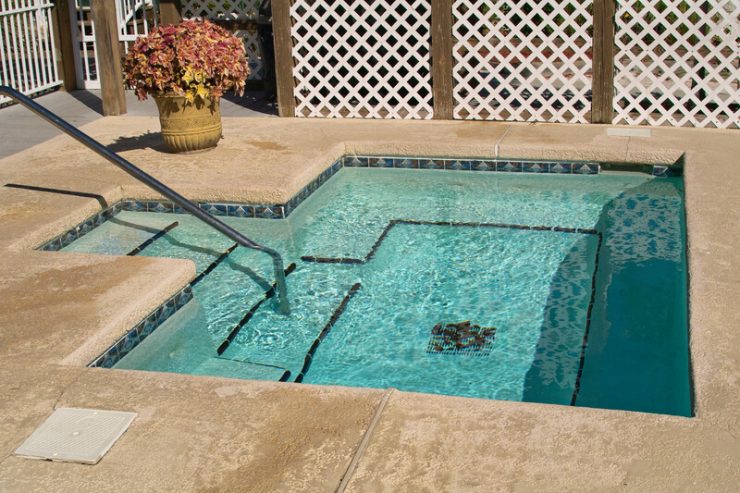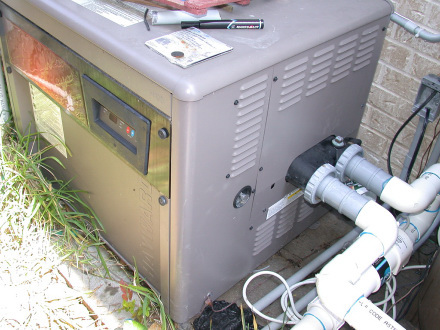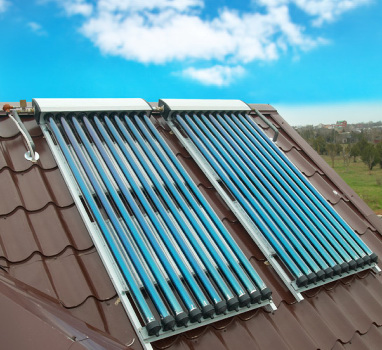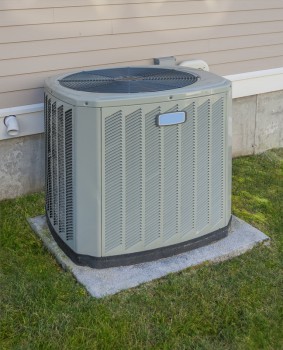Sometimes, you just want to relax in your pool and soothe your muscles in warm water especially during a cold day. On days like this, can you heat your plunge pool (aka dipping pool)? And what are the best plunge pool heating options?
The answers to these questions and more will be revealed in this post. So let’s dive in.
Plunge pools can be heated with the use of gas heating, solar heating, a heat pump or electric heater. They are cheaper to heat than full-sized pools, as they are smaller. A heat pump is usually the best heating choice as it is cost-effective and fast heating.

Article Contents
What is a Plunge Pool?
A plunge pool or dipping pool simply put is a mini pool. Plunge pools are designed for leisure and relaxation rather than swimming. Plunge pools have an average size of 10 x 22 feet and a depth of about 6 feet.
The smaller size dimensions when compared to normal pools make most people see plunge pools as hot tubs. But, plunge pools are larger than hot tubs, don’t have jets, and are usually installed in-ground.
However, just like a hot tub, you can also enjoy warm relaxing water in your plunge pool. How? By heating your plunge pool. Let’s check out some heating options for your plunge pool.
5 Top Heating Options For Plunge Pools
There are 5 ways you can heat your plunge pool. Each has its own pros and cons. Here are the top heating options for a plunge pool:
1) Gas Heating

You’ll need a significant budget for gas heating, but you can select your pool water temperatures practically down to the degree with the precision of gas heating.
A gas heating system is also the fastest heating system. A gas heating system can effectively heat your plunge pool in less than 60 minutes.
How does it work? A combustion chamber contains copper coils. Water exits your pool and travels through the coils. As gas burns in the combustion chamber, the copper coils warm-up and so does the water that’s traveling through them. Hot water exits the coils and goes into the pool.
If you’re an energy-efficient pool owner, gas isn’t the greenest heat choice, as we’re sure you probably already guessed.
Pros of A Gas Heating System
- A gas heating system is fast and can heat your plunge pool in less than an hour.
- You can heat your plunge pool with a gas system any time of day or year.
- Not dependent on the weather
Cons of Gas Heating System
- A gas heating system is an expensive option to run
- Gas systems are not eco-friendly
- Gas heater lifespan is short.
2) Electric Heating
Your next option is to use electricity for a warmer plunge pool. The efficiency of electricity is less than gas. This heating method is costly and again, not very eco-friendly.
How does it work? With electric heating in your plunge pool, the heating system will take in air, then separate the warmth from the air through its heat exchanger. The heat exchanger continues to collect warm air day and night. It’s also slow to heat the water.
Pros of an Electric Heating System
- Easy to install
- Can use it any time of day or year
- Not dependent on the weather
Cons of an Electric Heating System
- You can’t heat your plunge pool when there is a power outage or electrical fault.
- An electric heating system is expensive to run.
3) Solar Heating
Your third option and by far the greenest is solar heating. Rather than use finite resources like gas or electricity, solar heating relies on renewable solar energy. Your heating costs will be the lowest of all the heating systems, which is quite appealing.

How does it work? Your heating system will include an electric pool pump, like your pool’s filter pump, which sends water through capillary tubes. The pool water goes all the way to your roof to get to the capillary tubes, and is warmed by the sun.
Next, the water comes back down into your pool much warmer than when it exited.
Although it sounds effective, solar heating is completely dependent on the warmth of the sun. Without sunlight, your solar pool heater won’t work well. On overcast or rainy days, your solar system will be much less effective and at night, it won’t work. Winter is also a problem for solar systems.
Pros of Solar Heating System
- A solar heating system is a pocket-friendly option as you can run solar heaters on a low budget.
- A solar heating system is eco-friendly
Cons of Solar Heating System
- Solar systems rely heavily on the sun – if the sun isn’t warm and shining, then they are not effective.
- It takes longer to heat a pool with a solar heating system when compared to gas or electric heaters.
- Unless you have warm winters, they are not effective.
Related Reading: How Much Warmer Will Solar Heating Make my Pool?
4) Heat Pump

The last option is a heat pump.
How does it work? This uses electricity and operates much like an air conditioner in reverse. The heat pump “captures” the heat from air in the environment and then amplifies and transfers this heat to the water.
The result is a very efficient, cost-effective heating solution. These work very well, but they will not work in temperatures less than 50ºF (10ºC). The only viable option for winter heating is gas or electric.
Pros of Heat Pumps
- Heat pumps are the second-cheapest option to run.
- Heat pumps are eco-friendly as there is no harm caused to the environment.
Cons of Heat Pumps
- Heat pumps don’t work during the cold winter months which is usually when you’ll need a heater.
- Heat pumps are not as fast as electric or has heaters.
5) Solar Pool Blankets or Covers
A plunge pool blanket is not exactly a heater or heating system, but it can also get the pool water warmer or keep the heat in. Plunge pool blankets are best suited for use alongside another heating option.
How does it work? plunge pool blankets are designed with tiny bubbles on the surface of the material. The blanket allows UV rays from the sun to enter the plunge pool and the bubbles trap the heat in the pool creating a source of heat to get the water warmer.
They are an absolute must if you’re using another heating system as they will boost efficiency. They also will raise the temperature by a few degrees by themselves, making them the cheapest way to take the edge off cold water.
Pros of Pool Blankets or Covers
- A plunge pool blanket is a cheaper alternative
- A plunge pool blanket improves heat retention in the pool.
- A plunge pool blanket is eco-friendly
Cons of Pool Blankets or Covers
- Plunge pool blankets are very slow in heating the pool
- A plunge pool blanket only raises the temperature a few degrees
Related Reading: Pool Heating 5 Mistakes Download
How Much Does It Cost To Heat A Plunge Pool?
This depends on the heating option you are using for the plunge pool. Here is a chart displaying the average monthly cost of each plunge pool heating option.
| Plunge Pool Heating Option | Average Cost per hour | Average Cost Per Month | Average Cost per year |
| Gas System | $6.5 | $180 – $350 | $2160 – $4200 |
| Electric System | $6 | $160 – $400 | $1920 – $4800 |
| Heat Pump | $5 | $100 – $200 | $1200 – $2400 |
The average cost of running a solar heating system wasn’t indicated in the chart above because solar heating systems are very cheap to run.
Expect to pay about $2500-$5000 to install a solar heating system for your plunge pool.
Also, plunge pool covers and blankets weren’t covered either due to the same reason. On average, you can purchase insulated plunge pool blankets for $30 – $150.
Pro Tips To Follow When Heating A Plunge Pool
The following tips will help you heat your plunge pool quicker and better while still minimizing cost.
1) Use An Insulated Plunge Pool Cover
Insulated plunge pool covers are designed with insulation pads to improve heat retention and reduce moisture loss in the plunge pool. These covers should be used alongside a heating option like gas heating systems.
With a pool cover, you won’t have to run the gas or electric heating system as much. This guarantees improved heating efficiency, lower cost, and maximum relaxation.
2) Keep The Heating System On
If the heating system is kept on, the water in the plunge pool will maintain a warm temperature. But if you turn off the heater when the water is warm enough, the water will get cool quickly while you are using the pool.
This means you have to heat the water again from scratch. Contrary to popular belief, keeping the pool heater on helps to save cost and energy.
3) You Don’t Have To Get The Water Boiling Hot
Lowering the heating temperature of your plunge pool is a great way to save significant money on heating costs. Even lowering the temperature just a few degrees will reduce your bill by quite a bit.
4) Combine Two Heating Options
You always get more with two options than one. For instance, combining a gas heating system and a solar system will help you save cost. You can use the solar system during the day when it’s warm outside and the gas system at night or when the sun isn’t out.
5) Heat The plunge Pool When The Weather Feels Warm
The most effective time to heat your plunge pool is when it’s warm. The free heat from the sun will supplement your plunge pool heater, thus reducing the heating costs.
We have a full article on the best time to heat a swimming pool. Check it out here:
When Is the Best Time to Heat Your Pool? Day or Night?
Final Thoughts
Any one of the plunge pool heating options discussed above will work fine but ensure you consider your climate, pool size, and budget before picking a heating option.

